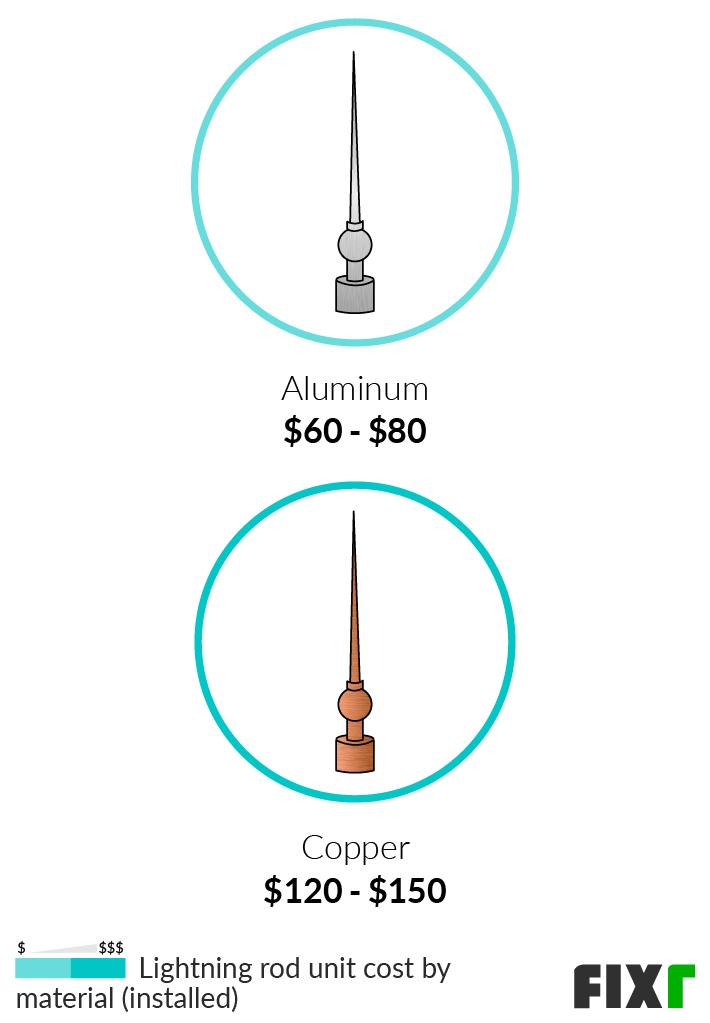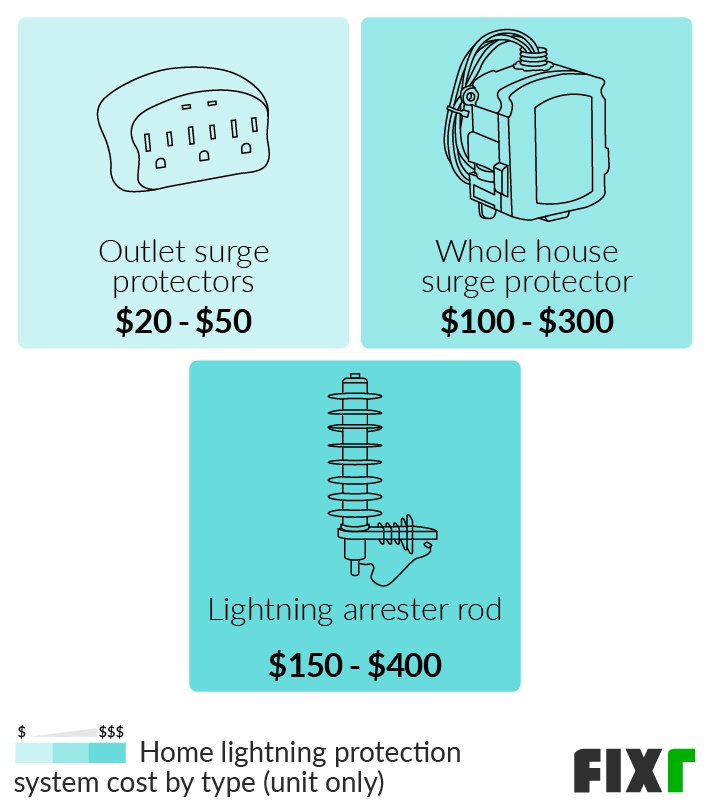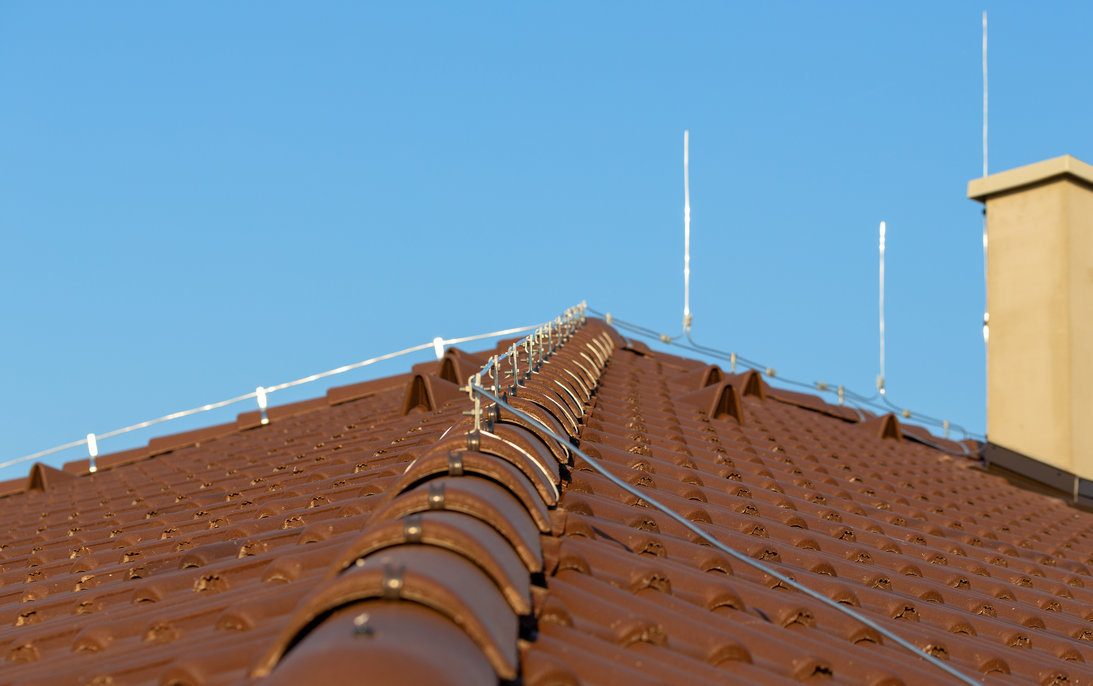Updated: January 31, 2025
Written by Adam Graham
Cristina has more than 4 years of experience in the remodeling and home design sector. She joined Fixr.com in 2017 and has since been working constantly with industry experts to bring the most accurate and reliable information regarding news, trends, and advice to homeowners and other industry pros. Her work has appeared in major industry publications, like Forbes, Realtor.com and the official publication of the National Kitchen & Bathroom Association.
Learn moreReviewed by Cristina Miguelez
Everyone knows that the odds of being struck by lightning are very low for individual people. But your house is a much bigger target. A single strike of lightning can do incredible damage to a typical property, destroying appliances, frying circuits, and even causing fires. This is why many homeowners consider lightning rod installation. With rods in place, your home is protected from lightning bolts. If a bolt lands on your property, the rod works to safely transfer the electrical power into the ground, protecting the property from damage. Lightning rods can save a lot of money in the long run and be installed professionally or by the homeowner, depending on the rods used.
The national average cost for installing a lightning rod is between $600 and $2,000. Most people pay around $1,100 for the professional installation of five simple copper lightning rods and several outlet surge protectors for a 2,000 sq.ft. home. At the low end of the spectrum, you can have three simple aluminum rods installed for $200. At the high end, you can pay up to $3,000 to install an ESE terminal with a whole house surge protector.
Lightning Rod Price
| Lightning Rod Installation Cost | |
| National average cost | $1,100 |
| Average range | $600-$2,000 |
| Low-end | $200 |
| High-end | $3,000 |
Lightning Rod Cost by Type
Your lightning rod installation costs range between $60 and $2,500, depending on the type you install. Lightning rods are divided into two main categories: simple and early streamer emission (ESE) air terminals. Simple rods are the easiest to handle and install but cover less square footage. ESE air terminals are much more complicated and costly to install but more efficient for protection. The table below shows the lightning rod installation cost for each type:


| Lightning Rod Type | Cost per Unit (Installed) |
| Franklin | $60 - $150 |
| ESE Air Terminals | $2,000 - $2,500 |
Franklin Lightning Rod
The Franklin lightning conductor pole price is between $60 and $150 per installed unit. Also known as simple rods, they can be made of copper or aluminum. They are the easiest to handle and install. Homeowners can install and replace these rods themselves. The lightning rods are shaped like an iron spike that is 8’ to 10’ tall. They are fastened to the highest point of a building, usually the tip of the roof. Depending on your home size, you may need multiple simple rods because they do not protect large spaces as ESE air terminals do.
Ese Air Terminals
ESE air terminals range from $2,000 to $2,500 per unit. Early streamer emission air terminals are much larger, more powerful, and more expensive than simple lightning rods. ESE air terminals are installed along with bonding conductors and cables that run to the ground to connect with grounding rods or plates in the earth. ESE air terminals should be several feet higher than the house, which is why they are typically installed along the perimeter of a flat roof or at the roof crest, chimney, or ridge. They protect a much larger surface area than simple rods, but you usually only need one ESE air terminal per home. An ESE air terminal must be professionally installed, so the lightning conductor price is higher.
Lightning Rod on House Cost by Material
The lightning rod price also depends on the material, with costs varying between $60 and $150 per unit. When buying simple lightning rods, you have two options for materials: aluminum and copper. Both these materials have their advantages and disadvantages. The cost to install lightning rods made of aluminum is cheaper. This is because aluminum is one of the most affordable materials, so even with the additional materials and labor, installation is almost half the price of copper. They can also be easily installed on bare aluminum or galvanized steel roofs. However, they are less efficient at conducting electricity.
In contrast, installing copper lightning rods is more expensive, but it conducts electricity more efficiently, and the connection cable does not need to be as long. The downside of copper rods is that they are not suitable for use on aluminum or galvanized steel roofs. The rubbing of non-similar metals speeds up oxidation and may even cause a fire. The table below shows the average price of each material:


| Lightning Rod Material | Cost per Unit (Installed) |
| Aluminum | $60 - $80 |
| Copper | $120 - $150 |
Lightning Rod Installation Cost
Labor costs are around 40% of the total cost of installing a lightning rod. This means that installing a set of six copper lightning rods on a standard family home costs about $440 in labor out of the total price of $1,100. The overall cost of installing lightning rods depends on the rod type and how big the job is. Aside from the rods, installation includes cables or wires that run to the grounding rods or another type of grounding and fasteners used to hold the cables or wires tightened to the rod. The total labor costs range from $100 to $1,000, depending on the amount of work needed. Installing a simple lightning rod is cheaper because it involves less work than installing a full ESE system. Many professionals charge between $35 and $50 per hour. Installing a few simple lightning rods takes a couple of hours or half a day, whereas installing a larger number of rods or an ESE system may require 12 to 16 hours of work or $420 to $800.
First, the professional installs the lightning rods on the roof, usually no more than 20 feet apart and at least one foot from the end of the roof. Then, they install the fasteners that hold the copper or aluminum wire. They connect the rods to the wire and run it along with the structural parts of the home. The wires are then connected to a conductive grid buried in the ground. Ideally, the groundings will be positioned on opposite corners of the home to ensure the whole perimeter is protected.
The biggest factor affecting the cost of installing a lightning rod is which rod type you choose. Simple lightning rods are easier and faster to install, while ESE air terminal systems are more complex to install and require a professional. Another factor is your home size. The larger the home, the more protection you need. Bigger roofs require multiple simple lightning rods to ensure they provide protection. If you have a large home and roof, the lightning conductor cost for an ESE system may be more cost-efficient because you will likely need only one rod to protect the entire property. The height of your home also affects the cost. Taller homes require longer cables and result in more work and longer installation times.
Home Lightning Protection System Cost by Type
Additional protection systems cost between $20 and $400 for the unit, depending on what you include. Aside from a lightning rod, the professional may recommend installing other protection systems. Each of them is designed to protect your household items and appliances by redirecting the lightning current. The most common additional lightning protectors for a house are outlet surge protectors, whole house surge protectors, and lightning arrester rods. Each of them, along with their costs, are explained below.


| Type | System Cost (Unit Only) |
| Outlet Surge Protectors | $20 - $50 |
| Whole House Surge Protector | $100 - $300 |
| Lightning Arrester Rod | $150 - $400 |
Outlet Surge Protectors
Outlet surge protectors cost $20 to $50 and can be installed by the homeowner. Large appliances that use electrical outlets are more susceptible to lightning strike damage, as the surge in power can damage their control boards. You should consider outlet surge protectors when you have several appliances that need a smaller scale of protection. Outlet surge protectors can be placed on individual electrical power outlets to protect certain devices and appliances like a TV or computer.
Whole House Surge Protector
Whole house surge protectors are built into your electric service panels and cost about $100 to $300 for the material only. They protect the home if it is struck by lightning by taking on the excess voltage and preventing it from harming appliances and other devices inside the house. Suppose you have a lightning rod system in place. Professionals often recommend purchasing a whole house surge protector as an added layer of protection, especially if you live in an area that has many lightning storms. Installing an outlet surge protector can be a DIY job with the right equipment. However, installing a whole house surge protector requires hiring an electrician. They can adequately and safely assess the main power panel box and install the whole house surge protector without the risk of electrocution.
Lightning Arrester Rod
The lightning arrester for a building price runs between $150 and $400 per unit. A lightning arrester rod prevents unexpected power outages or sudden surges by being fitted to power and telecommunication lines. If those lines are struck by lightning, the arrester transfers the current from the line into the ground rather than letting it flow into the house. You must contact your local power company to arrange the installation of lightning arresters.
What Is the Purpose of a Lightning Rod?
When lightning hits on or even near a structure, the electrical power it causes travels as a current inside the structure. This causes power surges, which are extremely brief spikes in voltages that vary in duration and magnitude. This power surge can cause damage, sometimes irreparable, to your household appliances and electronics. A lightning rod is designed to take the lightning strike current and transfer it to the ground, where it dissipates without causing harm to the property and the people and items inside it. The rod is installed at the highest point of the home to intercept the hit and direct it to the ground before it causes any damage.

Lightning Damage Repair Cost
When lightning strikes near the home, the energy travels through a utility pole and goes directly into the home’s electrical panel, causing an electrical surge. This can damage the electrical panel and its parts and large appliances in the home. Because the electrical panel distributes electricity in the house, several things may get damaged in the case of a lightning strike. Electrical panel repair costs range from replacing a switch for $200 to $300 up to $1,200 to $4,500 if the whole electrical panel needs replacing. If the surge has traveled through the electrical wires, it can burn their insulation and fuse them together. This requires rewiring, which runs $6 to $10 per sq.ft.
Electrical outlets are most commonly damaged during lightning strikes. However, they are also the cheapest to repair. If it gets damaged, you can replace an electrical outlet for $120 to $200 per unit, depending on the type of outlet. However, if all the outlets in your home have been damaged, replacing them can go as high as $900 to $2,000. If the electrical outlets do not have surge protectors, the appliances may get damaged. When the damage is minor, average electrical appliance repair costs $100 to $300. If the damage is irreparable, you would have to replace the faulty appliance, which would require paying its full price.
If the house suffers a direct lightning strike, which is a rare occurrence, it can cause physical damage to the house. The chimney may be damaged, which results in chimney repairs costing $250 to $1,200. If the roof gets damaged, roof repairs have an average cost of $300 to $1,500, depending on which part is damaged. The shock wave of the sound of a nearby lightning strike may also shatter windows. In most cases, this requires replacing the window glass, which has an average cost of $300 to $800.
Enhancement and Improvement Costs
Tree Lightning Protection
Tree lightning protection systems cost $200 to $400. The price varies depending on the tree size and the amount of work required. If you have trees around your property, especially within 10 feet, consider installing lightning protection for them. These systems can be fitted to trees of various species and sizes to protect them if lightning strikes. They function in the same way that a regular lightning rod protects a home. Without these systems, trees can catch fire, break apart, fall, or cause side flashes that may damage nearby trees and houses. Certain trees are more susceptible to lightning strikes, so protection systems are strongly recommended for tulip poplar, ash, oak, maple, and elm trees.
Additional Considerations and Costs
- Damage prevention. Statistics show that lightning does a lot of damage to unprotected homes across America, especially in stormy regions like Texas and Florida. Tens of thousands of insurance claims connected to lightning strikes are filed each year, and as modern homes include even more wiring and devices, the risks are higher than ever. Investing in lightning protection systems vastly reduces the risk of damage to your property and your electronic possessions.
- Discounts. Some insurance companies offer price reductions to homeowners who invest in home security and protection systems, including lightning rods. Speak with your insurance company to see if you qualify.
- Certified professional. The Lightning Protection Institute recommends hiring a UL-certified professional to install all lightning rods and ESE air terminals. These workers ensure that your system meets all safety standards.
- DIY. Even though you can install lightning rods on your own or with the help of friends, it is generally recommended to hire a UL professional to do the job. If you do it DIY, have a professional verify that you have the correct number and placement of the rods.
- Roofing material. Even if you have a metal roof, you still need a lightning rod to protect your home. Lightning can strike any roof, regardless of material, and a metal roof does not protect you from damage.
- Safety. The National Weather Service recommends going inside and staying there for the duration of a lightning storm. Stay away from phones, computers, and other corded electronic devices and from plumbing and water, including sinks and baths. Also, keep clear of concrete walls and openings around the home, like doors and windows.
- Permit. Depending on where you live, you may need to get a permit to install lightning rods, as you will be adding to the height of the roof. The cost of a permit runs between $50 and $500.
FAQs
- How much area does a lightning rod cover?
This depends on the type of lightning rod used. A 3,000-square-foot home would be covered entirely by one ESE air terminal system but would require 6 or 7 simple units.
- Does copper attract lightning?
No, copper does not attract lightning and will not increase the chances of your home being struck by lightning. However, it is a very good conductor of electricity, so it can be helpful when used in lightning protection systems and rods.
- Do people still install lightning rods?
Not every residential home requires a lightning protection system. However, as weather conditions worsen and get more extreme, homeowners install lightning rods as protection against the effects of lightning.
- Are lightning rods a good idea?
Lightning rods are recommended if your house is at risk of being struck by lightning. However, even if you live in areas with moderate lightning activity, the damage a lightning strike can cause is great, making the price of a lightning conductor worthwhile.
- Who needs a lightning rod?
If you live in areas prone to thunder and lightning storms, your home is tall, or there are trees taller than your home within 10’, it is strongly advisable to get a lightning rod. It protects household electronics, appliances, and the people inside.
